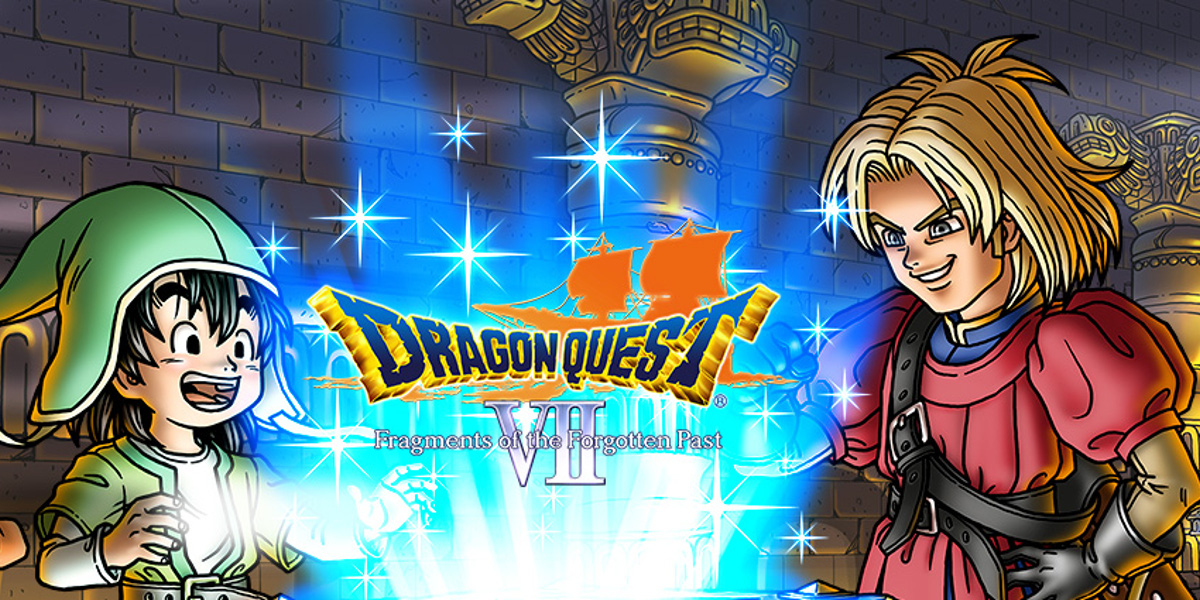Remakes and remasters seem to be a theme for many video game titles this year, and our latest review title is no different. Well, okay, it’s a little different. Dragon Quest VII: Fragments of the Forgotten Past is a new old game for the Nintendo 3DS family, and the developers have completely rebuilt the game from the knees up (because the game’s original story, setting, and characters are still very much in place). The original, which debuted on the PlayStation 1, was incredibly well received, so how do you improve on a game that’s already a classic? Come along, I’ll tell you.
Any long-time JRPG fan worth their mana-salts will know that one of the giants of the JRPG world is Dragon Quest, known as ドラゴンクエスト in Japan [Ed: You are one funny guy]. The Dragon Quest series, which began in 1986, was once developed and published by Enix, until Squaresoft merged with them, and in true Voltron form, became Square Enix. Fans lovingly refer to the company as “Squeenix”, but that’s considered bad form in the reviewing world, so I’ll refrain from using that nomenclature. Dragon Quest’s characters are all designed by famed manga artist Akira Toriyama (of Dragonball Z fame), and this lends the games an air of charm and authenticity that was rare for the day. These games rarely saw releases in European regions, and in fact, the first game in the series to hit our shores was Dragon Quest VIII: Journey of the Cursed King for PlayStation 2. In Japan, on the other hand, the game is a cultural phenomenon, and there’s even an urban myth about a visible drop in productivity and an increase in truancy with each Dragon Quest release. The game has only ten numbered titles in the series (and a dozen spin-offs), each game featuring a crazy paragraph’s worth of bytitle. While each game is anticipated with the kinds of heavy breathing you usually reserve for…well, pizza, true new titles in this series are comparatively rare.

Which brings us to Dragon Quest VII: Fragments of the Forgotten Past. The original PlayStation 1 release was divisive in some ways, particularly because the game’s opening chapters took about as much time to get underway as a procrastinating snail crossing a road of salt. The Nintendo 3DS release of the game can be said to be a drastic, even a dramatic improvement over the original in many, many ways. Not least in that the game’s story skips about two or so hours of bumf and fluff to get to the meaty bits. But we’re getting a bit ahead of ourselves here. Story time!
The tale of Dragon Quest VII starts in the little village of Pilchard Bay on the island of Estard with a character called…well, you call him what you want. I called him Flopsy because of reasons. Flopsy is the son of a great fisherman, and when he finds a mysterious fragment of a stone tablet on his father’s ship, he finds himself pulled into an adventure across the world and across time. Along with his friends Prince Kiefer and Maribel, he has to piece together the stone tablets to discover the truth about the world, and stop a great evil in the process. And as usual, anything I say more than that will count as traipsing merrily through spoiler country.

When I say the game has been rebuilt, I’m not kidding. You actually have to take a look at a comparison screenshot to appreciate just how much the game has changed from the original. The characters are now fully animated 3D objects in a beautiful, full 3D world. Battles are no longer random affairs, but are instead visible from the main screen (and mercifully avoidable if you’re looking to get somewhere quickly!). In addition to the speeding up the plodding progression of the original game, the battles have been rebalanced so that you’re not at constant risk of death anymore. The game’s soundtrack has received a full orchestral overhaul, and sounds absolutely fanfare-tastic. From the opening moments when the trumpets start blaring out the Dragon Quest theme I could tell this game had received a lot of love. And in the vein of “minor changes that we wonder at the logic of”, many of the game’s characters have received name changes. I couldn’t find a reason why, but if you’re wondering why the older game refers to “Gabo”, and there’s no such character, it helps to know he’s been renamed “Ruff”.
As usual for 3DS games, Dragon Quest VII contains Streetpass features, but explaining it involves a little bit of song and dance. A few hours into the game, you’ll find a mostly empty island. On this barren rock is a cavern that allows you to trade certain maps in exchange for fighting rare monsters. Naturally, these maps are very much in demand, and you can’t obtain all of them in the game alone, which is where Streetpass comes in, since you’ll exchange map pieces with other Dragon Quest VII players you pass. I personally find Streetpass in this country a little frustrating, since I never encounter enough players to make it worth my while, but it’s certainly something to keep in mind if you’re in a 3DS-heavy zone.

On the other hand, it’s still very much an old-school JRPG underneath all the new flashy lights and sounds, and some of the story progression elements could have used an update along with the rest of the game. I’m not sure if that’s the kind of thing that would aggravate purists, although I reckon that by dumping some of the slower story elements, we’re beyond the point of purity here. I digress, though. Let me give you an example of the kind of story progression stuff I’m talking about. Early in the game, you need to find Maribel, but it’s never made clear to you that this is what you’re doing, or that she’s anywhere in the vicinity. Not a clue, not a cigar, not even a sausage. And this isn’t the only example of this sort of aimlessness you’ll inevitably run into. I know that the Dragon Quest series is big on letting the player explore for themselves, but at some point it gets a little silly.
Another bizarre indication of the game’s age is the really odd saving mechanism. Dragon Quest VII, like other Dragon Quest games, presents the save points as churches, and when you save, you talk to the priest and perform confession. However, you also have the ability to quick save out in the field, but only if you quit the game immediately thereafter. You cannot quick save in a town, city, or dungeon. Except that I found that these were the precise times I wanted to save. Typical, isn’t it? “Simply close the 3DS and suspend the game! Just don’t run out of power!” the game tells you enthusiastically. Guess who was in a car, miles from a power supply? And since Nintendo uses a proprietary plug for the back of the 3DS, I couldn’t even plug in a powerbank. I lost a good couple of hours of gameplay that day.

One of the best things about Dragon Quest games is the fun that the translators seem to have with the game, in sharp contrast to something like Final Fantasy, which always took itself far more seriously. If Final Fantasy was J.R.R. Tolkien, then Dragon Quest is Terry Pratchett. It’s more than the cartoony nature of the character design. Even the names of monsters are ridiculously punny. There’s an enemy that looks like a bird, but it’s head is some kind of flower. The translators decided to call it a “Kingfuschia”. Get it? It’s like a kingfisher, but with a fuschia for a head? Fine. Don’t laugh. I thought it was witty. Whether you take this in stride depends on your tolerance for strange puns. Oh, and speaking of translators and books, when the game was translated from the original Japanese, there were over 70,000 pages of text to translate. I’m going to say this now: it’s a hefty game with a lot to say.
Loyal readers will know that I’m a huge fan of JRPGs, so replaying a remade version of Dragon Quest VII: Fragments of the Forgotten Past was an utter treat. While many of the game’s sensibilities have been remade for a modern audience, there are still some odd features that should ideally stay buried in the past. If you’ve ever wondered what the fuss was about, this would be a most excellent time to get stuck into it. And the best thing? Ridiculous value for money, since the game runs well over the hundred-hour mark. The story is still as brilliant as ever, and the characters are a joy to get to know (even if Flopsy himself doesn’t really develop much as a character).



